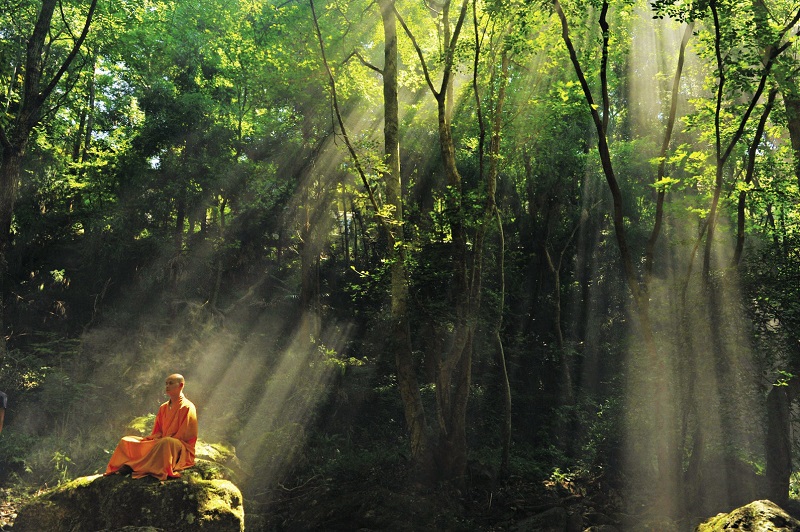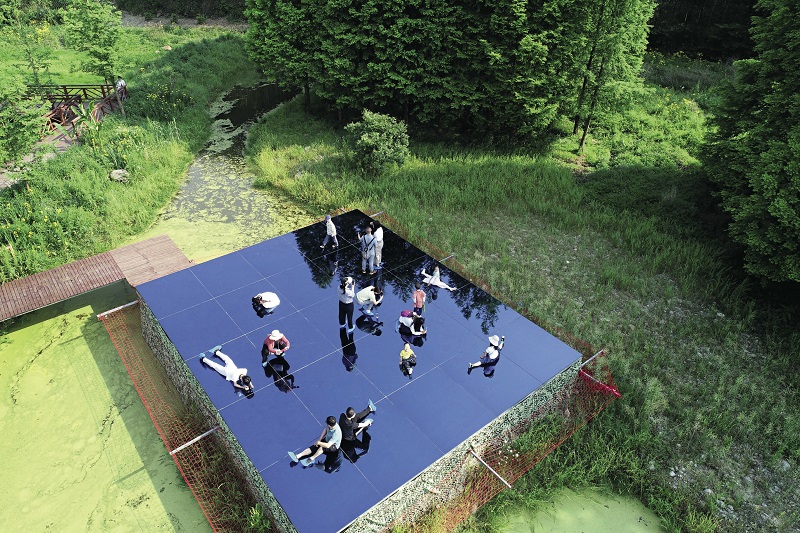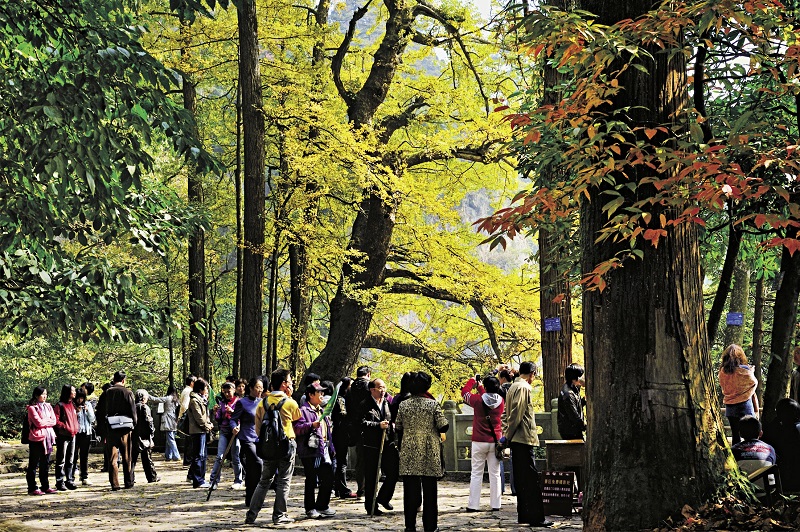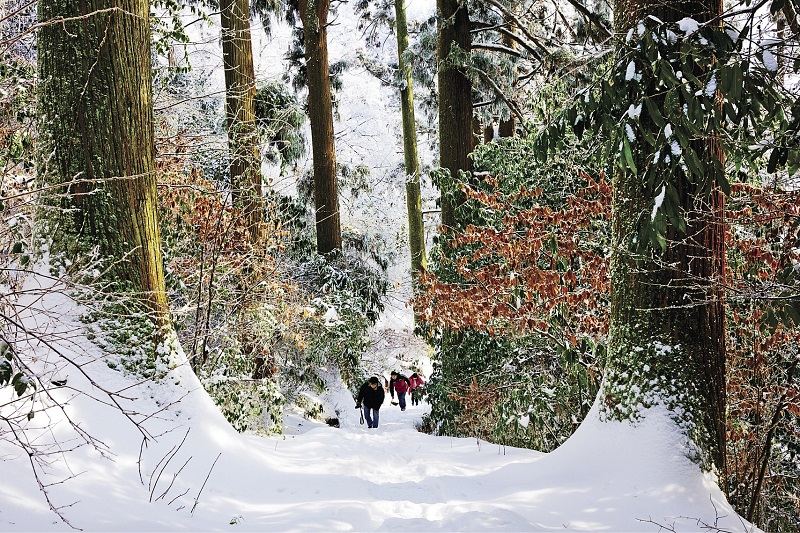Over the last 60 years, China’s efforts to protect the local ecological environment of the Tianmu Mountain National Nature Reserve has paid off in making it into a rare "gene bank of species" and "treasure house of cultural heritage."

A monk from the Chanyuan Temple in Tianmu Mountain meditating on a rock in the local forest on August 6, 2015.
In 1956, the reserve was designated a restricted forest area. Since then, many achievements have been made in protecting its natural resources. In 1986, it became recognized as one of the first batch of national nature reserves in China. Today, it is also a member of the Man and the Biosphere Programme, launched by UNESCO to establish a scientific basis for the improvement of relationships between people and their environments.

Tourists enjoy themselves outdoors at the Fuluo Scenic spot in Tianmu Mountain Village.
“Heaven on Earth”
Located in a region called “heaven on earth” because of its scenic beauty and balmy weather, the Tianmu Mountain presents a unique landform of cliffs and steep walls on its east slopes and deep valleys on the western side.
The reserve has a subtropical climate with four distinct seasons. It means it gets ample sunlight, strong monsoons with abundant rainfall, and enjoys moderate temperatures. Both the environment and surface water quality here meet the national first-class standards.
The vast forest, with an area of more than 4,000 hectares, has a rich variety of plants. The vegetation consists of four natural belts: evergreen broad-leaved forest, mixed evergreen and deciduous broad-leaved forest, deciduous broad-leaved forest, and deciduous dwarf forest.
Ginkgo biloba or maidenhair tree is native to China. It is the oldest surviving plant among gymnosperms, plants that propagate through seeds and without producing flowers, and so has been called a living fossil. The ginkgo tree grows slowly and has a very long life, as well as ornamental, economic, and medicinal value.
The Tianmu Mountain has lots of ginkgo trees that are more than 100 years old, including the one that is deemed as the world oldest, which grows on the cliff 960 meters above sea level. From its base, 22 trunks of different sizes have sprouted, thus winning for itself the name “five generations under one roof.” It serves as an excellent sample for study of how a ginkgo tree can survive thousands of years, braving changes of the nature.
Another special plant found here is the Ostrya rehderiana, a deciduous tree. There are only five large wild Ostrya rehderianas in the reserve, the largest of which is more than 300 years old and therefore of great importance for studying flora, taxonomy, species conservation, and ecological protection. Conservation measures have greatly improved the natural regeneration capacity of the species here. Both the gingko and Ostrya rehderiana are protected species.
This region is also home to rare and endangered animals. There are 45 species of animals under provincial protection which include the leopard, clouded leopard, tufted deer and white-necked pheasant. There are also 42 kinds of wild animals under state protection, such as the macaque and pangolin.

Tourists walk through one of Tianmu Mountain’s ancient ginkgo biloba forests looking at the bright colors of different generations of trees, some of which have root systems over 12,000 years old. Photo courtesy of Liu Bailiang
Volcano Grand Canyon
To the west of the Tianmu Mountain is the Tianmu Grand Canyon, also called the “Volcano Grand Canyon.” Inside the stone valley, there is a spectacular mountain promenade composed of forests, strange stones, waterfalls, craters, and glaciers. With a vegetation coverage of more than 95 percent, the scenic area earns its reputation of a “natural oxygen bar” with the content of negative icons in the air standing at 2,000-10,000 per cubic centimeters. There are also a lot of water amusement facilities suitable for playing water sports or training in the wild. It is a good place for spending one’s summer vacation.
The Tianmu Grand Canyon scenic spot was formed by the Quaternary glacial movement. The Quaternary Period started about 2.6 million years ago, after a volcanic eruption during the Jurassic Period. It led to extreme weather like the formation of ice sheets and caused the extinction of many species. Today, summer temperatures are lower in the valley than outside, reaching between 6 and 12 °C, making it an ideal haven from summer heat. A Chinese-style corridor path extends from the bottom of the valley to the top, protecting visitors from the sun and wind.

A group of hikers walk through the primeval forest of China cedars (Cryptomeria fortunei) in Tianmu Mountain National Nature Reserve during winter. Photo courtesy of Liu Bailiang
Rich Local Culture
The Tianmu Mountain is holy to both Taoism and Buddhism. In Taoism, it is a celestial mountain. The founder of a sect of Taoism, Zhang Daoling, is said to have been born here. The Buddhist temples in the mountain, like the Chanyuan Temple and Lion Zhengzong Temple, are popular destinations for both tourists and pilgrims.
The Chanyuan Temple, more than 350 years old, is surrounded by trees, some of which are as old. It is said to have been built by the order of Qing Emperor Shunzhi and Kangxi, who ruled in the 17th century, to carry on the legacy of Buddhism.
During the Chinese People’s War of Resistance against Japanese Aggression, a school in Zhejiang and Zhejiang University moved inland for safety from the invading army and temporarily functioned from the temple. The Chanyuan Temple has several elaborately decorated halls.
The profound religious culture and beautiful natural landscape of the Tianmu Mountain attracted monks, pilgrims, scholars, and eminent people during the reign of different dynasties and they gifted or made paintings, poems and precious objects to the temple, leaving a precious cultural heritage.